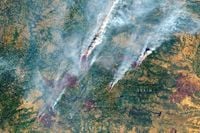As the embers of one of the most devastating wildfire seasons in the Iberian Peninsula’s history cool, a sobering reality is coming into sharper focus: human-caused climate change has made the kind of extreme heat, dryness, and wind that fueled the fires in Spain and Portugal up to 40 times more likely than in the preindustrial era. That is the central finding of a rapid attribution study released Thursday by the World Weather Attribution (WWA) group, which has sent shockwaves through scientific and political circles across Europe.
From late July through August 2025, hundreds of wildfires swept through Spain and Portugal, driven by temperatures that soared above 40 degrees Celsius (104 Fahrenheit) and relentless, desiccating winds. According to the European Union’s Copernicus Climate Change Service, Europe has been warming at twice the global average since the 1980s—a trend that played out in dramatic fashion this summer. The fires killed at least eight people, forced the evacuation of more than 35,000 residents, and scorched over 640,000 hectares (1.58 million acres), accounting for roughly two-thirds of Europe’s total burned area this year, as reported by the Associated Press.
Researchers from WWA zeroed in on the extraordinary weather conditions that allowed these wildfires to spread with such ferocity. Spain experienced its hottest ten-day period on record in August, with the national weather agency AEMET confirming that the heatwave lasted 16 days and brought temperatures 4.6°C higher than the historical long-term average. Since 1975, only six out of 77 heatwaves in Spain have had an anomaly of 4°C or more—five of those occurring since 2019, according to data cited by Carbon Brief.
“Hotter, drier and more flammable conditions are becoming more severe with climate change, and are giving rise to fires of unprecedented intensity,” said Clair Barnes, a researcher at the Centre for Environmental Policy at Imperial College London and a co-author of the WWA study, in comments to multiple outlets. She called the size of the fires “astonishing” and warned, “Unfortunately, these fires are a sign of what is to come. With every fraction of a degree of warming, extreme, long-lasting heatwaves will continue to intensify, increasing the chance of huge wildfires like the ones that burned vast areas of the Iberian Peninsula.”
The WWA’s analysis found that the hot, dry, and windy spells that fueled the 2025 fires were not only 40 times more likely due to climate change, but also about 30% more intense compared to the preindustrial era. Without the influence of climate change, such a combination of conditions would be expected only once every 500 years. Now, in a world that has already warmed by 1.3°C, they can be expected roughly every 15 years. The study also concluded that the 10-day August heatwave in Spain was 200 times more likely and 3°C hotter because of human-induced climate change.
The consequences of these conditions have been nothing short of staggering. In Spain, more than 380,000 hectares burned—almost five times the country’s annual average—while in Portugal, the fires consumed over 260,000 hectares, nearly 3% of its landmass and close to three times the annual average, as detailed by the WWA and reported by Al Jazeera. Together, the two countries accounted for two-thirds of the one million hectares burned across Europe in 2025, the worst wildfire season since the Copernicus European Forest Fire Information System began keeping records in 2006.
The wildfires’ toll extended beyond human tragedy and property loss. According to the WWA, the fires devastated protected national areas and habitats for 395 endangered, vulnerable, or specially protected species across Spain and Portugal. The environmental impact was compounded by the release of 39.4 million tonnes of CO2 emissions from European wildfires between January and early September 2025—more than triple the emissions recorded during the same period last year, as noted by Carbon Brief.
Spain’s State Meteorological Agency described the August heatwave as the “most intense on record.” The Carlos III Health Institute estimated that more than 1,100 deaths in Spain could be attributed to the 16-day heatwave. Smoke from the fires led to hazardous air quality in both Spain and Portugal, with plumes drifting as far as France, the UK, and Scandinavia, according to Euronews.
While the fires were driven by extreme weather, researchers and policymakers have also pointed to longstanding social and land management issues that exacerbated the crisis. Large-scale rural depopulation and an aging population in both Spain and Portugal have left vast tracts of forest and farmland unmanaged, creating dense fuel loads highly vulnerable to ignition. The Associated Press quoted Ricardo Trigo, a professor at the University of Lisbon, who explained, “From a human perspective, most of these rural areas have suffered massive abandonment since the 1970s, which has allowed fine fuels to accumulate to dangerous levels, a problem worsened by inadequate forestry management.”
The public debate in Spain has increasingly focused on the decline of traditional rural activities—such as grazing by sheep, horses, and goats—that once kept vegetation in check. Researchers recommend a combination of mechanical clearing, controlled burns, and the revival of grazing to reduce fire risk. As Friederike Otto, a climate science professor at Imperial College London, put it to Euronews, “For wildfires, there’s an urgent need to control vegetation in rural areas, particularly land that has been abandoned by farmers and shepherds.”
Firefighting resources across Europe have been stretched to the breaking point. Spain made its first-ever request for international firefighting reinforcements to the European Civil Protection Mechanism during the height of the crisis. Prime Minister Pedro Sánchez described it as likely the largest such request ever facilitated by the EU. The situation prompted Sánchez to propose a 10-point plan on September 1, 2025, aimed at better preparing Spain for natural disasters worsened by climate change, including closer coordination with Portugal and France.
Experts warn that, with climate change increasing the frequency and severity of extreme weather, adaptation measures are struggling to keep pace. Theodore Keeping, a researcher at the Centre for Environmental Policy, cautioned, “Firefighters are increasingly working in chaotic and unpredictable conditions, tackling fires that behave in ways they’ve never seen before.”
Ultimately, as Professor Otto emphasized, the world faces a stark choice: “The wildfires in Europe show that 1.3°C of warming today is already incredibly dangerous. Without a faster shift away from fossil fuels, we could hit 3°C this century. Wildfires at this level would be catastrophic.”
The 2025 Iberian wildfires serve as a grim warning—a convergence of climate, land management, and social challenges that demand urgent attention from governments, scientists, and citizens alike.






